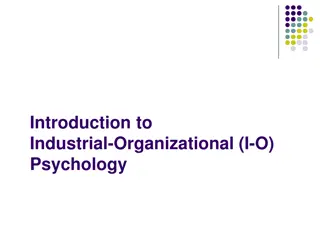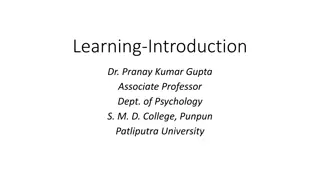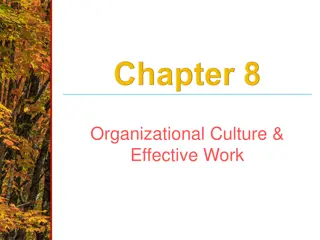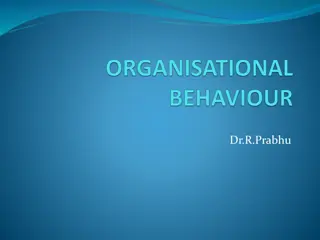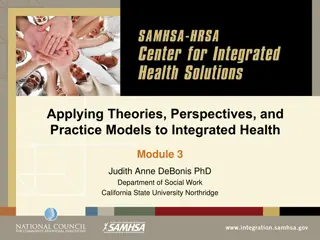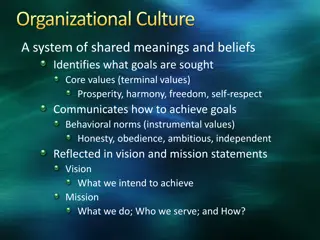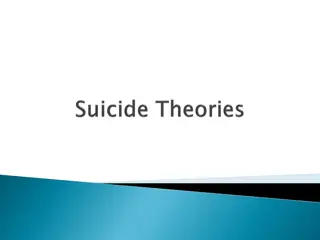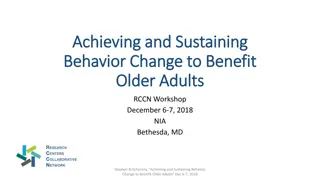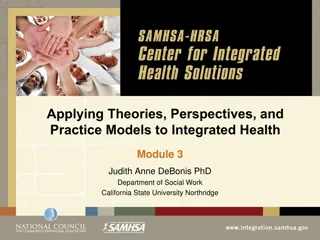Introduction to Organizational Behavior: Management Theories and Practices
Explore the evolution of organizational behavior from early management theories to contemporary practices. Understand the historical foundations and relevance of management theory in shaping workplace dynamics. Delve into key concepts like Scientific Management, Administrative Management, Bureaucratic Management, Human Relations Theory, General Systems Theory, and X&Y Management Theory. Discover how these theories have influenced organizational behavior and the workplace environment.
- Organizational Behavior
- Management Theories
- Workplace Dynamics
- Historical Foundations
- Contemporary Practices
Download Presentation

Please find below an Image/Link to download the presentation.
The content on the website is provided AS IS for your information and personal use only. It may not be sold, licensed, or shared on other websites without obtaining consent from the author. Download presentation by click this link. If you encounter any issues during the download, it is possible that the publisher has removed the file from their server.
E N D
Presentation Transcript
Organizational Behavior Module 1: Introduction to Organizational Behavior
Module Learning Outcomes Describe the field of organizational behavior and discuss its relevance to the workplace 1.1: Describe the general history of management theory and practice and frame how organizational behavior has developed from these into a discreet field 1.2: Describe organizational behavior and differentiate between the three levels of influence 1.3: Describe contemporary issues and topics in organizational behavior
Management Theory and Organizational Behavior
Learning Outcomes: Management Theory and Organizational Behavior 1.1: Describe the general history of management theory and practice and frame how organizational behavior has developed from these into a discreet field 1.1.1: Describe the history of management theory 1.1.2: Differentiate among Scientific, Administrative, and Bureaucratic Management Theories 1.1.3: Differentiate among Human Relations, General, and X&Y Management Theories 1.1.4: Describe the relationship between management theory and organizational behavior
Management Theories Started in the Industrial Revolution Needed to organize work for many Leverage better technology Management theories help organizations Focus Communicate Evolve
Early Management Theories (early 1900s) Scientific Management Theory (Taylor) Championed the efficient and effective completion of tasks Administrative Management Theory (Fayol) Fourteen pillars for organizational strength and health Bureaucratic Management Theory (Weber) Encouraged detailed company objectives and division of labor
Later Management Theories (19201960) Human Relations Management Theory/The Hawthorne Effect (Elton Mayo) Human interaction and management influences productivity General Systems Theory (von Bertalanffy) The sum of an organization s productivity is dependent on the health of all its parts X&Y Management Theory (McGregor) X management approach employees are inherently lazy, hate work Y management approach employees are internally motivated
Organizational Behavior (1970s) Bureaucratic Management Theory Human Relations Theory Administrative Management Theory Systems Theory Scientific Management Theory X&Y Organizational Behavior Management Theory
Practice Question 1 In addition to advances in technology, ________ was a large motivation in the development of management theory during The Industrial Revolution. A. industry regulations B. turnover C. sustainability D. productivity
Practice Question 2 Which of the following statements describes the Scientific Management Theory? A. Fourteen principles which created strong, successful companies B. The belief that workers are lazy and need to be coerced into performing C. Finding the most efficient and effective ways to complete tasks D. A clear division of labor and clearly defined tasks
Practice Question 3 How is management theory connected to organizational behavior? A. Management theory established the foundation for organizational behavior B. The same theorist who developed management theory developed organizational behavior C. There is no connection between organizational behavior and management theory D. Organizational theory helped to develop management theory
Learning Outcomes: Organizational Behavior as Its Own Field 1.2: Describe organizational behavior and differentiate between the three levels of influence 1.2.1: Describe how organizational behavior evolved into its own unique field 1.2.2: Differentiate between the three levels of influence
Understanding Organizational Behavior The academic study of an organization through the behavior of its members Intended to explain behavior and make behavioral predictions Incorporates components of management, psychology, leadership, personality traits, motivation, etc.
Three levels of influence The individual The group The organization
Practice Question 4 How is organizational behavior unique? A. It includes a wide range of topics and is always adapting B. Behavior is a simple topic and a common academic study C. Organizational behavior is another management theory D. Organizational behavior is not unique
Practice Question 5 What are the three levels of influence? A. Individual, group, and organization B. Logical, emotional, and cooperative C. Informational, psychological, and biological D. Private, public, and corporate
Learning Outcomes: Contemporary Issues 1.3: Describe contemporary issues and topics in organizational behavior 1.3.1: Analyze the benefits and complications of telecommuting 1.3.2: Examine the growing focus on green business practices and sustainability 1.3.3: Analyze the benefits and complications of outsourcing 1.3.4: Describe the different workforce generations and their impact on the workforce
Telecommuting Positive Qualities Allows employees to work anywhere, anytime Better work/life balance for employees Fewer distractions outside the office environment Better employee retention Lower cost for organizations no need to provide office Negative Qualities Requires employees to be self-motivated Harder to manage employees that aren t in close proximity Reduced daily interactions between employees Non-telecommuters resent employees who are able to do so Positive Negative
Green Business Practices Increased focus on sustainability as consumers become more aware Organizations struggle to reconcile sustainability practices with business goals and profitability
Outsourcing The practice of hiring external assets to provide services to help perform job functions typically done by internal employees Enabled by modern technology Freelancing
Class Activity: Outsourcing Get into groups of five or more, and be ready with a pen and a piece of paper. Together, you re going to write a three-paragraph story about two children and their trip to the grocery store for their mother. First paragraph: Include why they must go to the grocery store. Second paragraph: Talk about the people the children meet at the grocery store, and what items they actually purchase. Third paragraph: The children return home with their purchases, and present them to their mother. Include their mother s reaction and resolve the story. Take two minutes to discuss the plot of your three paragraph story Now start writing! But wait! Two of you must split off and write the second paragraph of the story without any interaction with the rest of the group from this point forward
Workforce Generations Three generations active in today s workforce: Baby Boomers Generation X Generation Y (Millennials)
Practice Question 6 Select one of the benefits of telecommuting. A. Self-motivation B. Limited face-to-face meetings and interactions C. Working from anywhere, anytime D. Telecommuters can work with people who work full time
Practice Question 7 Which of the following is a complication of outsourcing? A. Range of employee skills B. Advanced technology C. Multiple backgrounds and cultures D. Increased profit margins
Practice Question 8 Which workforce generation created meeting culture? A. Generation X B. Baby Boomers C. Generation Z D. Generation Y
Quick Review Management theories developed when managers struggled with the best way to manage large numbers of people and developing technology Management theories gave way to organizational behavior as a discipline, which studies how groups influence organizations Three levels of influence within organizational behavior are Individual Group Organization Contemporary issues that organizational behavior attempts to address include Telecommuting Outsourcing Workforce generations






